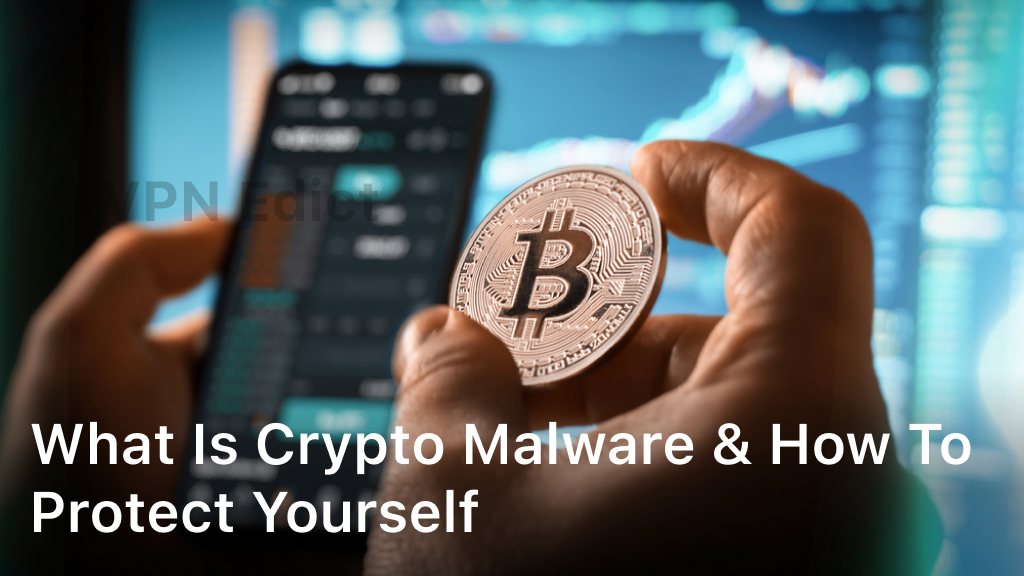What Is Crypto Malware & How To Protect Yourself
Welcome to our guide on crypto malware and how to protect yourself from this growing cyber threat. In today’s digital age, where cryptocurrency transactions have become increasingly popular, it’s crucial to stay informed and safeguard your financial assets. Crypto malware is a type of malicious software designed to target individuals’ digital wallets and steal their valuable cryptocurrencies.
In this article, we will explore what crypto malware is, understand its risks, and provide practical tips for preventing and detecting it. We will also discuss measures you can take to protect yourself against crypto malware and what steps to take if you become a victim of an attack.
By the end of this guide, you’ll have the knowledge and tools necessary to keep your cryptocurrencies secure and enjoy the benefits of this exciting digital ecosystem without falling prey to malicious actors.

Understanding Crypto Malware and its Risks
Crypto malware, also known as cryptocurrency malware, poses a significant threat to individuals in the digital realm. It is a type of malicious software designed to target cryptocurrency users, aiming to exploit their valuable assets. Understanding the specifics of crypto malware is crucial in order to protect oneself from potential attacks and financial loss.
Crypto malware attacks can occur through various means, including phishing emails, malicious websites, or infected downloads. Once the malware infiltrates a system, it can wreak havoc by stealing sensitive information, compromising cryptocurrency wallets, and even locking users out of their accounts through ransomware.
The Risks Associated with Crypto Malware:
- Loss of Funds: Crypto malware can result in the loss of hard-earned funds stored in cryptocurrency wallets. Hackers can exploit vulnerabilities in systems and gain unauthorized access to wallets, enabling them to transfer funds without permission.
- Identity Theft: With access to personal data, crypto malware attackers can steal identities and use the information for various fraudulent activities, including opening fake cryptocurrency accounts or conducting unauthorized transactions.
- Ransomware Attacks: Crypto malware may employ ransomware tactics, encrypting essential files and demanding payment in cryptocurrency for their release. This can lead to significant financial loss and disruption of daily operations.
- Reputation Damage: Falling victim to a crypto malware attack can tarnish one’s reputation, especially if the compromised accounts are tied to professional or business activities. Trust from clients and partners can be undermined, resulting in lasting repercussions.
It is important to be aware of the risks posed by crypto malware and take proactive steps towards protecting oneself from potential attacks. In the following sections, we will explore strategies to prevent, detect, and protect against crypto malware, as well as options for removing infections and securing compromised accounts.
Preventing and Detecting Crypto Malware
In today’s digital landscape, protecting oneself from crypto malware is of utmost importance. This section provides practical tips and strategies to prevent and detect crypto malware, ensuring the safety and security of your digital assets.
1. Install Antivirus Software
The first line of defense against crypto malware is to install reputable antivirus software on your devices. This software can detect and remove malicious programs that may attempt to compromise your cryptocurrency holdings.
2. Regular System Updates
Keeping your operating system and applications up to date is crucial for preventing vulnerabilities that can be exploited by crypto malware. Enable automatic updates or regularly check for updates to ensure your software is equipped with the latest security patches.
3. Practice Safe Browsing Habits
Be cautious when clicking on links or downloading files from unfamiliar sources. Avoid visiting suspicious websites or engaging in activities that may expose your devices to potential crypto malware infections.
4. Stay Informed about Latest Threats
Stay abreast of the latest news and developments in the world of cryptocurrency and cyber threats. Educate yourself about the types of crypto malware that are currently prevalent and the techniques utilized by attackers. This knowledge will help you identify potential threats and take appropriate preventive measures.
5. Exercise Caution with Email Attachments and Links
Be wary of emails from unknown sources that contain attachments or links. These may serve as vehicles for crypto malware infections. Avoid clicking on suspicious links or downloading attachments that could potentially compromise your digital security.
6. Enable Two-Factor Authentication
Implementing two-factor authentication adds an extra layer of security to your online accounts. By requiring an additional verification step, such as a unique code sent to your mobile device, you can prevent unauthorized access and protect your cryptocurrency holdings from potential theft.
7. Encrypt Your Wallets
Encrypting your cryptocurrency wallets provides an additional safeguard against unauthorized access. By encrypting your wallet, you make it more difficult for attackers to steal your digital assets even if they gain access to your device.
8. Practice Strong Password Hygiene
Utilize strong, unique passwords for all your online accounts, including your cryptocurrency exchange platforms and wallets. Avoid using easily guessable passwords and consider using password managers to securely store and generate complex passwords.
By following these preventive measures and staying vigilant, you can significantly reduce the risk of falling victim to crypto malware and protect your valuable cryptocurrency investments.
Protecting Against Crypto Malware and Removing Infections
In addition to the preventive measures discussed in the previous sections, there are additional steps you can take to protect yourself against crypto malware attacks. By implementing these measures, you can minimize the risk of infection and ensure the security of your cryptocurrency investments.
1. Use Multi-Factor Authentication
Enabling multi-factor authentication adds an extra layer of security to your cryptocurrency accounts. By requiring a second form of verification, such as a unique code sent to your mobile device, you can prevent unauthorized access even if your login credentials are compromised.
2. Encrypt Your Wallets
Encrypting your cryptocurrency wallets adds an extra level of protection to your digital assets. This ensures that even if your wallets are accessed by malicious software, the information stored within them remains encrypted and unreadable.
3. Practice Good Password Hygiene
Creating strong, unique passwords for your cryptocurrency accounts is essential. Avoid reusing passwords across multiple platforms and consider using a password manager to securely store and generate strong passwords.
4. Regularly Update Your Software
Keeping your operating system, antivirus software, and cryptocurrency wallets up to date is crucial in protecting against known vulnerabilities. Regular updates often include security patches that address potential weaknesses that may be targeted by crypto malware.
Removing Infections and Securing Compromised Accounts
If you suspect that your device has been infected with crypto malware, it is important to take immediate action to mitigate the damage. Follow these steps to remove infections and secure your compromised accounts:
- Disconnect from the internet to prevent further communication between the malware and remote servers.
- Use reputable antivirus software to scan and remove the crypto malware from your device.
- Change the passwords for all your cryptocurrency accounts to prevent unauthorized access.
- Contact the customer support of affected cryptocurrency platforms for further assistance and to report the incident.
- Consider seeking professional help in restoring your accounts and recovering any lost funds.
By taking these precautions and promptly addressing any potential crypto malware infections, you can significantly reduce the risk of falling victim to cybercriminals and protect your valuable cryptocurrency investments.
Conclusion
In the rapidly evolving digital landscape, protecting oneself against crypto malware is essential. By understanding the risks associated with crypto malware and taking proactive steps to prevent infections, individuals can safeguard their digital assets and personal information.
Regularly updating security measures is crucial in defending against emerging threats, including crypto ransomware. This includes keeping antivirus software up to date, implementing strong passwords, and regularly updating operating systems and applications.
Equally important is maintaining a vigilant approach to online activities. Practicing safe browsing habits, such as avoiding suspicious websites and refraining from clicking on unknown links, can significantly reduce the risk of falling victim to crypto malware.
If you suspect that you have become a victim of crypto malware, it is essential to take immediate action. Disconnect from the internet, contact a cybersecurity professional for assistance, and report the incident to the appropriate authorities. Promptly removing infections and securing compromised accounts can help minimize the potential damage caused by crypto malware.
By staying informed about the latest crypto malware threats and diligently implementing preventive measures, individuals can protect themselves against this growing cyber menace. Remember, prevention is the key to avoiding the devastating consequences of crypto malware attacks.
FAQ
What is crypto malware?
Crypto malware, also known as cryptocurrency malware, is a type of malicious software that targets cryptocurrency users and their digital assets. It typically aims to steal or encrypt cryptocurrency wallets, holding them hostage until a ransom is paid.
How does crypto malware infect systems?
Crypto malware can infect systems through various means, including phishing emails, malicious websites, software vulnerabilities, and infected downloads. It often disguises itself as legitimate software or files to trick users into executing or installing it.
What are the risks associated with crypto malware?
The risks associated with crypto malware include financial loss, compromised personal information, and the potential for unauthorized access to other online accounts. Crypto malware can lead to significant financial and privacy implications if precautions are not taken.
How can I prevent crypto malware?
To prevent crypto malware, it is essential to keep your software and operating systems up to date, use reputable antivirus software, exercise caution when clicking on links or downloading files, and enable multi-factor authentication whenever possible. Additionally, staying informed about the latest threats and adopting safe browsing habits can help protect against crypto malware attacks.
How can I detect if my system is infected with crypto malware?
Signs of a crypto malware infection include sudden system slowdowns, frequent crashes, unusual error messages, and unauthorized activity on your cryptocurrency wallets or accounts. If you suspect that your system has been compromised, it is recommended to run a thorough malware scan using antivirus software and seek professional assistance if needed.
How can I protect myself against crypto malware?
To protect yourself against crypto malware, it is crucial to use strong and unique passwords for your cryptocurrency wallets and accounts, regularly back up your data, enable encryption on your wallets, and practice safe internet habits. Avoid clicking on suspicious links or downloading files from unknown sources, and be cautious when sharing personal information online.
What should I do if I become a victim of a crypto malware attack?
If you become a victim of a crypto malware attack, it is important to take immediate action. Disconnect your infected device from the internet, report the incident to the appropriate authorities, and seek professional help to remove the malware and secure your compromised accounts. Additionally, consider changing passwords for all your online accounts and monitoring your financial statements for any unauthorized transactions.
How can I remove crypto malware from my system?
Removing crypto malware from your system can be challenging, and it is recommended to seek professional assistance. Disconnect your infected device from the internet and consult with cybersecurity experts or use reputable malware removal tools to clean your system thoroughly.




